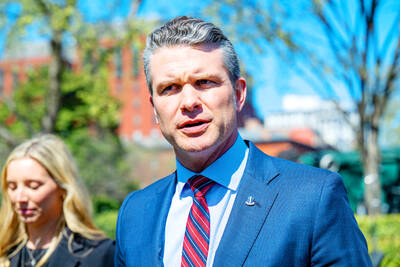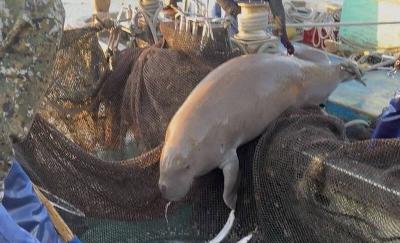Many people may have had reservations about whether the loosely-knit Wild Strawberry Student Movement would be capable of staging a successful and peaceful rally as planned when they heard that the students had decided not to report their planned protest to the police in defiance of the Assembly and Parade Law (集會遊行法).
Even Ho Tung-hung (何東洪), an associate professor of psychology at Fu Jen Catholic University and a participant in the Wild Lily Student Movement (野百合學運) of the 1990s, expressed reservations when talking to the Taipei Times several days prior to Sunday’s demonstration.
Ho, who had been offering advice to the Wild Strawberries as a student movement veteran, had expressed doubts about whether the students would be able to handle such a large-scale rally.
Some people opposing the Wild Strawberries also left messages on the students’ official Web blog (tion1106.blogspot.com), alleging that violence and chaos could break out during the rally.
But the students’ peaceful 2.7km march to the nation’s major government branches on Sunday and the large number of participants the parade attracted proved the skeptics wrong.
The Wild Strawberries were able to maintain order with a team of students tasked with keeping the peace. They had been trained by several non-governmental organizations experienced in staging rallies.
Although they seemed inexperienced, the team helped control traffic and the pace of the parade as the protesters marched down Zhongshan S Road, Zhongxiao E Road and Ketagalan Boulevard, which are among the busiest sections of downtown Taipei.
The civil disobedience training the students had received prior to the rally, given by Chien Hsi-chieh, director of the Peacetime Foundation of Taiwan, also proved successful, as the students resorted to applause and cheers instead of violence when stopped by police officers on several occasions.
The enthusiasm of the students appeared to have also infected hundreds of supporters of the movement who marched with them, even though some of the supporters were overheard saying that “the students’ action would not be as effective as throwing gasoline bombs, like we did in the old days.”
The police’s tacit agreement to allow the students to finish the rally also helped keep the demonstration nonviolent. An officer from the nearby Zhongzheng First Precinct was overheard saying that the police had decided not to block the students’ demonstration.
But the students still struggled to prevent other civic groups from stealing their thunder.
As the students were discouraging a group of elderly people from holding banners advocating de jure Taiwanese independence, one of the elderly protesters complained about the students’ interference.
“They are fighting for our freedom [of speech]. How can they limit our freedom?” the man said.
The students also spent quite some time persuading two participating vehicles to remove their political flags.
Also See: What we have forgotten about human rights in the last 60 years

‘DENIAL DEFENSE’: The US would increase its military presence with uncrewed ships, and submarines, while boosting defense in the Indo-Pacific, a Pete Hegseth memo said The US is reorienting its military strategy to focus primarily on deterring a potential Chinese invasion of Taiwan, a memo signed by US Secretary of Defense Pete Hegseth showed. The memo also called on Taiwan to increase its defense spending. The document, known as the “Interim National Defense Strategic Guidance,” was distributed this month and detailed the national defense plans of US President Donald Trump’s administration, an article in the Washington Post said on Saturday. It outlines how the US can prepare for a potential war with China and defend itself from threats in the “near abroad,” including Greenland and the Panama

A wild live dugong was found in Taiwan for the first time in 88 years, after it was accidentally caught by a fisher’s net on Tuesday in Yilan County’s Fenniaolin (粉鳥林). This is the first sighting of the species in Taiwan since 1937, having already been considered “extinct” in the country and considered as “vulnerable” by the International Union for Conservation of Nature. A fisher surnamed Chen (陳) went to Fenniaolin to collect the fish in his netting, but instead caught a 3m long, 500kg dugong. The fisher released the animal back into the wild, not realizing it was an endangered species at

The Chinese Nationalist Party (KMT) is maintaining close ties with Beijing, the Democratic Progressive Party (DPP) said yesterday, hours after a new round of Chinese military drills in the Taiwan Strait began. Political parties in a democracy have a responsibility to be loyal to the nation and defend its sovereignty, DPP spokesman Justin Wu (吳崢) told a news conference in Taipei. His comments came hours after Beijing announced via Chinese state media that the Chinese People’s Liberation Army’s Eastern Theater Command was holding large-scale drills simulating a multi-pronged attack on Taiwan. Contrary to the KMT’s claims that it is staunchly anti-communist, KMT Deputy

The High Prosecutors’ Office yesterday withdrew an appeal against the acquittal of a former bank manager 22 years after his death, marking Taiwan’s first instance of prosecutors rendering posthumous justice to a wrongfully convicted defendant. Chu Ching-en (諸慶恩) — formerly a manager at the Taipei branch of BNP Paribas — was in 1999 accused by Weng Mao-chung (翁茂鍾), then-president of Chia Her Industrial Co, of forging a request for a fixed deposit of US$10 million by I-Hwa Industrial Co, a subsidiary of Chia Her, which was used as collateral. Chu was ruled not guilty in the first trial, but was found guilty